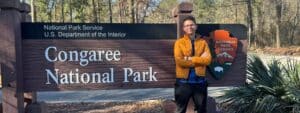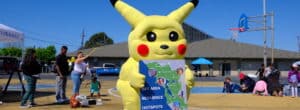John Grennan
On Oakland’s Broadway Auto Row, a storefront at the corner of 28th Street marked “Bay Bridge Kia” doesn’t showcase cars with steel wheels or tinted windows. Instead, a lone mannequin in a wedding dress occupies the display window of the tan, flatiron-style 1920s building. Nearby, a small typewritten sign announces upcoming fashion exhibitions in this otherwise vacant space. On an adjacent window, a green and white placard conveys a familiar message for spaces along the auto row: “Available.”
“In the last two years, Ford closed, Kia closed,” said Frank Guzman, a salesman at Toyota of Oakland near the corner of 41st Street, a three-minute drive from the former Kia dealership. “But we’re here. Audi’s here. Cadillac’s still here. We’re holding our own,” he said.
Auto sales across the country plummeted 18 percent in 2008, dropping to their lowest annual level since 1992. Broadway’s Auto Row between Grand Avenue and 42nd Street exhibited symptoms of the downturn, with dealers like Saturn, Jeep and Dodge—in addition to those listed by Guzman—closing their doors within the last year. But even with the uncertain state of the economy in general and the auto industry in particular, several Broadway car dealers are determined to stay on the row.
Their ability to do so depends in part on two potential City of Oakland development proposals. The first proposal–a 27-acre West Oakland auto mall designed to shift auto sales away from North Oakland and give the city’s auto dealers a larger, more visible hub—is on hold indefinitely.
Meanwhile, a second and more significant proposal involves converting more than 10 acres of Broadway between Grand Avenue and Interstate 580 into an Upper Broadway shopping and residential district. Some auto dealers will likely stay on Broadway regardless of what happens with the plan, but it could mean the 15-block stretch would no longer be dedicated primarily to auto sales for the first time in almost a century.
The city hopes to create 1 million square feet of new retail space on the empty and underused portions of Auto Row, which officials say could help keep shopping dollars in Oakland that otherwise go to Emeryville’s Bay Street or other shopping centers. “Right now, there’s $1 billion dollars of retail leakage from Oakland and other local residents purchasing comparison goods like clothing, furniture and sporting goods in places other than Oakland,” said Keira Williams, a retail specialist with the city’s Community Economic Development Agency (CEDA). “That represents $10 million in sales taxes, which could be funding a lot of police officers and libraries.”
It’s hard to imagine the North Oakland stretch of Broadway without the auto row; Oakland residents have been buying cars here almost since the first Model T rolled off Henry Ford’s assembly line in Detroit. In 1914, Buick opened one of Oakland’s first dealerships at 3300 Broadway, near Honda of Oakland today but then close to Saint Mary’s College, which outgrew its campus and relocated to Moraga in 1928.
Business has ebbed and flowed along Broadway’s Auto Row since then, with some dealers following Saint Mary’s out into the suburbs. The current recession has brought the latest round of tougher times, with showrooms on Broadway closing even before American car companies went to Washington for bailouts in December. But Oakland has a vested interest in promoting car sales; it collects up to 14 percent of its annual sales taxes from car sales, according to the city’s own data. Broadway Auto Row accounts for the largest share of those car sales, along with a few other dealers like Lexus located near the Oakland Coliseum.
Sales taxes form an especially important part of Oakland’s city budget. According to Oakland Metropolitan Chamber of Commerce Director of Research Scott Peterson, Proposition 13, a California law passed by voters in 1978, significantly limits proceeds from property taxes. “Considering the reality for any municipality in the post-Proposition 13 environment, it’s important to generate any revenue cities can keep locally,” Peterson said. “Sales tax is the most lucrative, and auto sales can help since with bigger purchases the city gets bigger checks.”
With these revenue imperatives in mind, Oakland officials recognize the importance of keeping auto dealers in the city. But the City Council and other leaders have asked whether all these sales need to take place on Broadway, so close to downtown and other residential centers. For much of the last decade, the council encouraged auto dealers to consider relocating from Broadway to a proposed 27-acre auto mall on the decommissioned Oakland Army Base in West Oakland, an area with more acreage and freeway access than Broadway.
In November 2005, well before the current economic crisis hit, CEDA reported that the city was facing the loss of existing auto dealers on Broadway within four to six years due to rising land values, new housing developments, pressure from the auto manufacturers to modernize facilities, and substandard physical conditions on Broadway Auto Row. But after problems attracting investors and obtaining environmental clearances, in May the City Council temporarily shelved its plan to open an auto mall on the old army base.
“The Chamber of Commerce supported the [Oakland Army Base auto mall] development effort which, at that time, had the auto retail industry moving toward freeway-adjacent malls like the ones in Walnut Creek and Daly City,” Peterson said. “But the industry as a whole collapsed before the city could assemble the land.”
Even as the city tries to keep the $3 to $4 million it earns from auto sales taxes annually, however, officials also want to focus on capturing some of the $10 million in sales taxes that CEDA’s Williams said Oakland loses to retail shopping centers in adjacent cities.
Revitalizing empty stretches along Broadway’s Auto Row forms an essential part of Oakland’s broader retail strategy. In a June presentation on the proposed Broadway development project, CEDA identified 37 percent of the 242 parcels along Broadway between Grand Avenue and Interstate 580 as “empty or underutilized.” Williams noted that Oakland could put a shopping district the size of downtown Walnut Creek into the Upper Broadway neighborhood and still have room left over.
These empty spaces along Broadway also present Oakland with a unique green growth opportunity according to Marla Wilson, a sustainable development analyst with the Greenbelt Alliance, who promotes denser use of the downtown area through “infill” projects that will add to the businesses already there. “The Bay Area is set to grow by nearly 2 million residents by 2035,” Wilson said. “But all that growth can be accommodated through infill development projects (like Upper Broadway). Oakland is one of the Bay Area cities with the greatest potential for infill development. That means there’s no excuse for sprawl.”
City efforts to revitalize the district could help draw customers to the auto row, according to Broadway auto dealers like Volkswagen salesman David Alkassmi. “I’m from San Diego originally. People used to be afraid to go to downtown, but now downtown is prime space in San Diego,” he said. “I hope the city has the same vision in this part of Oakland.”
City-facilitated community discussions about the Upper Broadway plan began in May, with the next community session scheduled for November 5 at the First Presbyterian Church on 2619 Broadway. The discussions are anticipated to continue for two years.
As the city re-envisions what Broadway during the next decade, many auto dealers along the row insist they are there for the long haul. “We’re staying,” Volkswagen’s Alkassmi said from inside his office in the German carmaker’s Autobahn-themed showroom. “We have customers who come from San Francisco, Walnut Creek and Berkeley as well.”
Volkswagen has company among other import brands that sell well in the Bay Area. Honda of Oakland actually expanded in recent years, moving in 2005 into a former Val Strough Chevrolet space near Interstate 580.
“Our store, Mercedes, Audi, and Volkswagen—they’re all really nice-looking stores,” said Honda general manger Jim Totah from his dealership’s high-ceilinged building that looks something like a vast downtown loft. “This is a historical building. We’d invite anyone to come and see our dealership—we’re happy to show them around.”
Whether or not the city ultimately tries to create an auto mall in West Oakland or another location, several auto dealers on Broadway say their loyal customer base will allow them to stay in place. “We have customers from Piedmont, Montclair,” Toyota’s Guzman said. “They still have money, and you’d be surprised the number of them who pay cash for cars.”
In addition to support from steady customers, the U.S. government-sponsored “Cash for Clunkers” initiative last month provided a fillip to Broadway’s auto sellers. The program, which offered customers up to $4,500 to trade in cars for more fuel-efficient models, helped boost national auto sales by 26 percent over July’s figures. With cars like the Toyota Corolla and Honda Civic among the top-selling models during the Cash for Clunkers period, Broadway auto dealers say they benefited from the program.
“Our store did twice as much business last month than usual,” Volkswagen’s Alkassmi said, although, he added, “We took business away from this month—we took deals and moved them up earlier.”
But even if auto sales pick up on Broadway in coming years, stretches of vacant lots and boarded-up buildings will likely remain, possibly until a city redevelopment plan moves forward. “Some parts of Broadway look like a ghost town,” Guzman said. The former Connell used car lot at 30th Street near Alta Bates Hospital, for example, is among the largest vacant parcels, with faded flags blowing in the breeze above cracked asphalt.
These empty lots are part of what make Oakland officials see Broadway as prime territory for new retailers. CEDA surveys show that Oakland residents are receptive to the idea of bringing in new stores to Broadway and favor a mix between large anchor stores like Target and smaller locally owned businesses. So far at least, nothing about the Broadway redevelopment plan suggests that new retail space and the preservation of existing car dealerships on Broadway would be mutually exclusive.
“The city is looking to enliven the commercial corridor on Broadway as part of the city-wide retail strategy, and is mindful that keeping some auto dealers there is beneficial to the overall approach,” the Chamber of Commerce’s Peterson said.
Regardless of what happens in the Broadway renovation project, car dealers who intend to stay on the row say fundamentals of the car business haven’t changed since their predecessors sold Packards and Studabakers to Oakland drivers along the same road.
“It all depends on if we have the car they want at the price they want,” Guzman said. “It’s all about the bottom line.”
###
http://oaklandnorth.net/2009/09/28/on-auto-row-tempering-troubled-times-with-visions-for-the-future/



